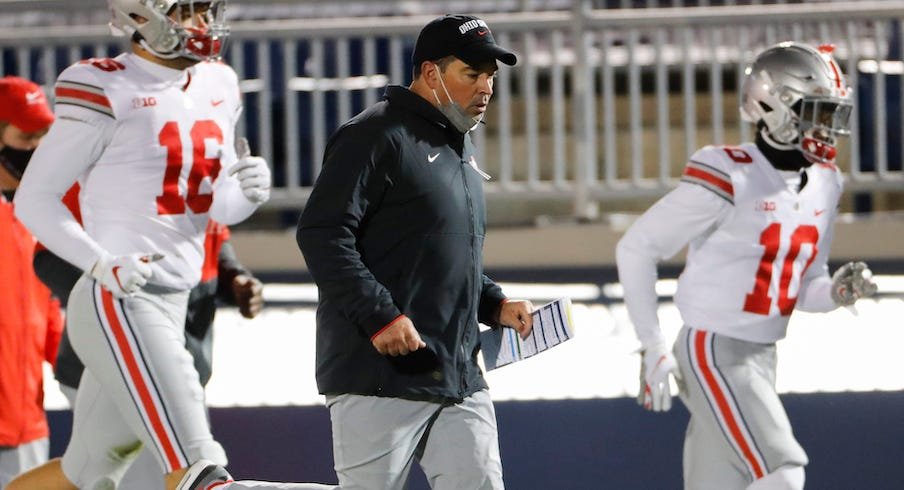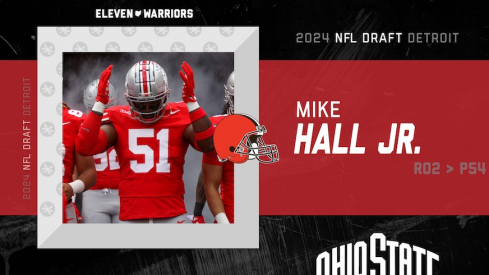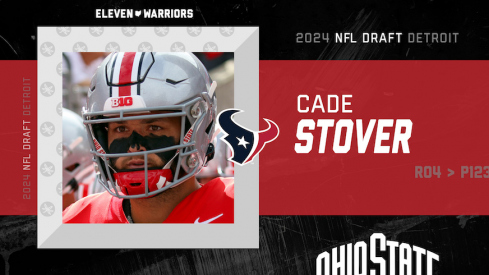Usually, Ryan Day’s weekly press conference is filled with questions and answers specific to Ohio State, the past game and upcoming opponent. That was the case on Tuesday, as expected, but the second-year head coach also delved into a number of topics related to Big Ten and NCAA policies, including Justin Hilliard sitting out the 38-25 win against Penn State, Saturday’s end-of-half fiasco, the players’ day off for Election Day and the decibel level in stadiums.
Here are Day’s thoughts on some of the hot topics of the week.
A False Positive
Justin Hilliard, a sixth-year linebacker, traveled with Ohio State to State College, Pennsylvania, and watched Saturday’s game from the sidelines. He didn’t, however, get to play in the showdown under the lights.
Once he arrived, he took a rapid-response COVID-19 test, which came back positive. A subsequent PCR test – which takes longer, is generally seen as more accurate and is used to confirm a test result – came back negative for coronavirus. Thus, it was deemed a false positive.
Still, per Big Ten rules, he was unable to suit up with the Buckeyes and enter the game since he had tested positive once.
“The way the Big Ten protocol is is that he was still not allowed to play, which is about as heart-wrenching as you could imagine,” Day said. “We talked about it before the game as a team. We're going to keep Justin in the back of our mind. We're not really sure why that happened to him, but maybe that was some sort of intervention or whatever. But we felt awful for Justin.
“I know it's something that is being discussed and will continue to be discussed to try to find out ways to make it better. But that was the policy that was in place. I know the Big Ten's continually talking about it and trying to figure out what's the best thing moving forward.”
As long as Hilliard continues to test negative for COVID-19, he will be able to make his season debut against Rutgers after also missing the season opener against Nebraska.
Still Confusing
By now, you know what happened just before halftime of Saturday’s Ohio State-Penn State matchup. Justin Fields took a knee and both teams ran to the locker room only for the referees to pull them back onto the field after ruling one second still remained on the clock.
If you need a reminder, here’s how Day felt in the moment:
Afterward, Day called it “probably the most bizarre thing I’ve ever experienced.” As expected, Ohio State took its thoughts to the Big Ten. Day, on Tuesday, confirmed the program contacted the conference about what happened.
“I don't really want to get into the details of it all,” Day said. “Apparently, there was more than two seconds on the clock, which I still don't understand. I didn't really get into it very much. I'm just going to move on.”
Presumably, he means between two and three seconds remained on the clock. Either way, he’s going forward.
Off For Election Day
In a normal week, Ohio State’s players return to the Woody Hayes Athletic Center on Sundays for film and light work, get Mondays off, then return to daily practices leading up to kickoff on Saturday. Due to Election Day on Tuesday, this week’s schedule has been altered. Day, in an industry that operates primarily on routines, called it “significantly different.”
The Buckeyes went through what Day called a “really good” and “very spirited” practice on Monday instead of Tuesday, since the NCAA mandated all athletes have the day off to vote or take part in civic events.
“It's the same with everybody across the board,” Day said. “We just have to handle it better than Rutgers. It is what it is. I think just about all of our guys and coaches have already voted. It is what it is. We're just going to handle it, hopefully, better than our opponent.”
Louder Than You’d Think
At some point, perhaps a certain number of fans of Big Ten teams will be allowed into stadiums to watch games. Jeff Potrykus of the Milwaukee Journal Sentinel reported on Tuesday that the conference “plans to revisit having limited fans in the stands.”
For now, though, fewer than 2,000 people – including players, coaches, team personnel, guests of players and everyone else in the stadium – are able to be inside stadiums for games. Naturally, that has led to a bit of a different atmosphere for the Buckeyes to deal with, both at home where they lack a 100,000-plus-person advantage and on the road where they don’t have to deal with a rowdy crowd.
“Being on the field and playing in the game without a crowd is very, very different, for sure,” Day said. “I don't think it's the same.”
However, as he notes, it’s far from quiet. In fact, he doesn’t think most people understand just how loud it is inside the building.
“The games I see on TV, you don't feel that,” Day said. “But there's 90 decibels going on in the game. Sometimes it's louder than being in a stadium. It's very, very difficult to communicate. And I don't know if that really shows during the game when you're watching it on TV. Turn it up to 90 decibels in your house and try to communicate with somebody with a mask on. It's virtually impossible. I mean, it's really hard. And then it's banging around in the stadium because there's no fans to absorb the sound. So it's still not easy, but it's very different than having 105,000-107,000 people in the stands.”
Ahead of the season, the Big Ten released its rules for in-stadium decibels. They’re fairly simple and straightforward – though there’s, perhaps, some room for interpretation of what exactly qualifies as a “celebration moment.”
- Audio during games: 70 decibels (equivalent to office noise of the inside of a car going 60 miles per hour)
- Audio during celebration moments: A maximum of 90 decibels (equivalent to a subway or a shouted conversation)
So, after experiencing pumped-in noise for two games, does Day think the decibel level allowance should change?
“I think it's very hard,” Day said. “They limit the amount of people that are actually on headsets to graduate assistants and full-time coaches. So if you're trying to communicate with anybody other than that and they have the crowd noise up to 90 ... The only time the rule is it's at 70 when the center's over the ball. So any other time, they can crank it up to 90, which is very, very hard to communicate. It is what it is. That's what was agreed upon. But it's a major challenge.”


